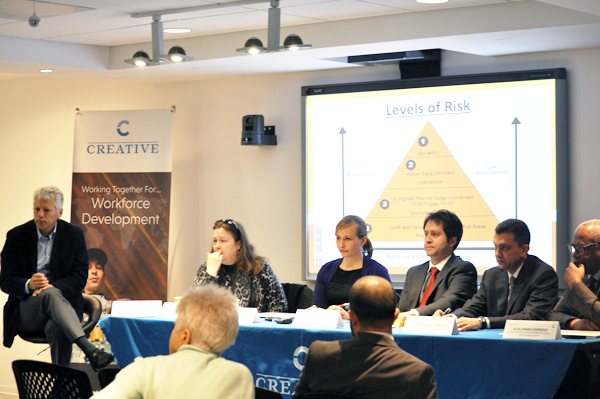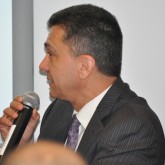Pinpointing risk, strengthening families to reduce violence
By Jennifer BrooklandFebruary 6, 2014

A panel of experts exploring youth violence reduction models used in Los Angeles and a new pilot program in Honduras say targeted approaches that focus on at-risk families are more likely to get communities closer to achieving that goal.
“Over the years, we’ve looked at the problem through a wide-angle lens and come up with big solutions, and we’ve looked through a close-up lens and come up with individual solutions,” says Guillermo Cespedes, Creative Associates International’s Senior Associate for Crime and Violence and Prevention. “This model also looks in the middle,” referring to an approach used in Los Angeles since 2007.
Speaking at a roundtable organized by Creative, the model Cespedes analyzed is aimed at “secondary prevention,” which targets those at highest risk for gang affiliation—children aged 10 to 15 living in poorer neighborhoods with elevated crime rates.
Even for these kids—who must survive absent parents, foster care and violence—Cespedes reminded that only 3 percent to 15 percent will join a criminal group. The Los Angeles model created a way to pinpoint those who are most likely to do so, and intervene before they get sucked in.
It evaluates youth based on risk factors and behaviors including delinquency, substance abuse and negative peer influence. Then it uses a systems-based, family-centric approach that starts with family meetings and strategy sessions and involves dedicated teams of social workers and counselors.
Multigenerational coaching and bonding, from learning Grandma’s recipes to creating a map of family relationships, encourages healthy norms and a strong personal identity that can withstand the lure of belonging to a gang.
“It is messy but I think professionally we do have a mandate,” Cespedes says. “We’re trying to strengthen institutional capacity. This is really a small piece of that, but you can think of it as strengthening the family as an institution.”
Cespedes helped develop this family-based secondary prevention model as Deputy Mayor of Los Angeles, a post he relinquished in December to bring his successful strategies to Central American neighborhoods he acknowledged were on the receiving end of an exported problem.
Honduras’s dangerous neighborhoods
Today, some urban neighborhoods in Honduras are among the most dangerous non-war zones in the world.
“Kids in San Martin cannot go to their own school because a neighboring gang controls that street,” says Salvador Stadthagen, who directs Creative’s Alianza Joven-Honduras program. “Another community, Estados Unidos, was completely closed down. Not even vaccinations were happening.”

Stadthagen’s program, a two-year-old extension of a regional initiative funded by the U.S. Agency for International Development (USAID), expanded Youth Outreach Centers in these communities; They offered safety and support to all youth in the area, but are not set up to target those who are most at risk of joining gangs.
“Most donors work in primary prevention,” Stadthagen explains. “We found that the reality was that we were working with kids in secondary prevention without having secondary prevention tools.”
Now, pilot projects that employ a more targeted approach like the one used in Los Angeles are now underway as part of Stadthagen’s Honduras program and in Monterrey, Mexico.
They replace the historically preferred support for law enforcement and focus instead on evaluating individual risk and behavior, building community and family resilience and bolstering positive institutions like churches and schools.
“There is a tendency to define an entire community or all of its youth as being at-risk,” says Jennifer Peirce, a citizen security and justice expert with the Inter-American Development Bank. “Getting a more individualized understanding would be helpful.”
Stadthagen and donors are all hopeful they will generate more data on what works in keeping the most vulnerable youth away from dangerous groups.
“We’re very excited about what we can learn from this and how, moving forward, we can integrate it into our portfolio,” says Enrique Roig, Coordinator of USAID’s Central American Regional Security Initiative.
Ideally, donors would fund integrated and overlapping programs that work with youth over the course of their lives, Roig says.
“To really be effective in these communities we have to work with youth who are criminally involved, those who are already involved in gangs and keep youth from becoming involved in criminal activity,” he says.
That paragon motivates Cespedes as well. It also keeps him up at night, he says.
“We know there are strategies that are effective at addressing one level or another, but as a community of practice, our next challenge is to implement all these levels of intervention in the same community,” he says. “There isn’t a model that’s complete. We’re still building the plane as we’re flying it.”
